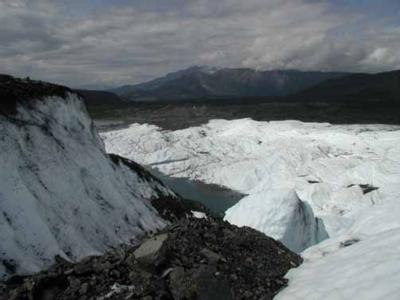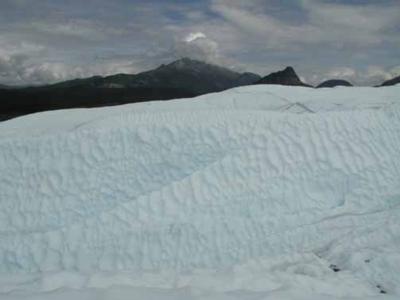15 July, 2000
July 15, 2000
Matanuska Glacier, Alaska
The weather has been rainy every day since last Sunday so it was quite
nice to wake up to clear blue skies this morning. Today is a pretty
quiet day and the only task for the day was to measure conductivities of
the samples we collected yesterday. Later we will head to Wasilla for
showers and then on to the airport in Anchorage to pick up a researcher
who will join us in camp for awhile. On the return trip we will once
again stock up on groceries, returning to camp late in the evening.
Tomorrow another researcher will arrive in camp. His name is Dr. Jeffrey
Strasser and he’s from Augustana College. He will have with him a small
group of college students who are taking part in a program called
Research Experience for Undergraduates (REU). This program, like TEA,
is sponsored by the National Science Foundation and provides
undergraduates in all areas of science an opportunity to experience the
processes of scientific research. There are a number of different REU
programs in place providing research opportunities throughout the world.
While the students are here they will spend roughly a week exploring the
glacier with Dr. Strasser in a sort of “Glaciology 101” class. During
the remaining weeks of their experience they will take turns spending
one week as helpers to Justin Pearce and Ben Cashman who are collecting
data and maintaining the camp for Cold Regions Research and Engineering
Lab (CRREL). The students will also design and carry out their own small
research project with their remaining time. Justin and Ben Cashman are
both past parcticipants in REU programs. My partner Ben Burnette is part
of the current group of REUs. He was sent up early in order to work with
me on our dye tracing research project. All at once the population in
camp will have more than doubled. It should be interesting.
Ben and I are looking forward to Dr. Strasser’s arrival. He will bring
with him some literature on past dye tracing studies. This information
will help guide us a bit and keep us from reinventing the wheel so to
speak. Although we have not given up on our current method, we are
looking forward to trying out the dye. In spite of having no success
with our salt conductivity approach as yet, it will not have been a
wasted effort if in the end it does not work out. When talking about our
project with a hydrologist who stopped in the other day he said that it
quite possibly is not a working approach for determining moulin/vent
connections. “What you’re doing is not easy work. All the easy stuff has
been done out here”. A lot of science is trial and error. Our salt study
will either succeed or fail. A positive outcome means that others may
use the same methods in the future. If we find the method cannot work,
then others will probably not spin wheels doing the same thing again. So
even if we come up with nothing our efforts have not been wasted.
Marvin Giesting

From yesterday's hike, looking back over the glacial lake toward the southern part of the terminus.

Yesterday's hike paralleled many ridges of ice. Each ridge was sufficiently wide and level enough to walk across but would end with steep inclines making further travel impossible without ice climbing gear.
Contact the TEA in the field at
.
If you cannot connect through your browser, copy the
TEA's e-mail address in the "To:" line of
your favorite e-mail package.
|
